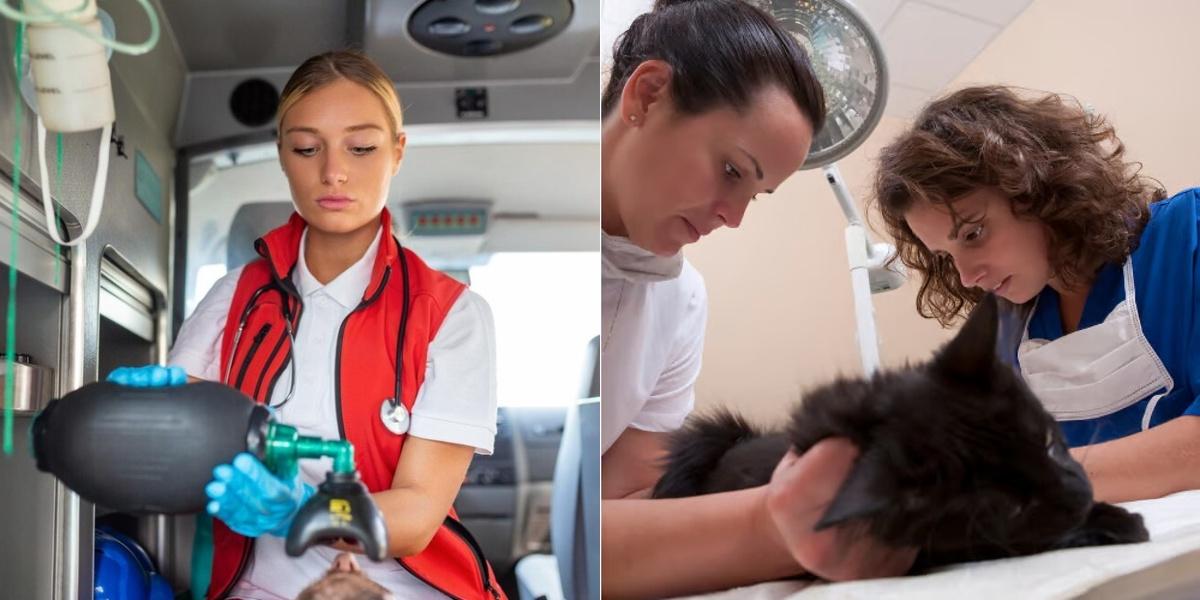Emergency Medical Technician vs Veterinary Assistant

Are you interested in a healthcare career but unsure whether to work with people or animals? Both EMTs and Veterinary Assistants play vital roles in the healthcare system, but their focus, training, and career paths differ significantly.
This guide compares these two careers, including responsibilities, salaries, and job outlooks, to help you decide which path fits your goals.
Key Points:
- EMTs provide emergency medical care to humans, while Veterinary Assistants care for animals under the supervision of veterinarians.
- EMTs typically earn higher salaries than Veterinary Assistants.
- Job growth is strong for both roles, with Veterinary Assistants experiencing slightly faster growth.
- EMT programs are more intensive and costly, while Veterinary Assistant programs can be completed more quickly and affordably.
- EMTs focus on life-saving techniques, while Veterinary Assistants handle animal care and assist with procedures.
Veterinary Assistant:
- Education: High school diploma or GED required.
- Training: Short-term programs (6–12 months) offered online or in-person.
- Certification: Not always required but Approved Veterinary Assistant (AVA) certification can boost job prospects.
- Additional Skills: Hands-on experience with animals through internships or volunteer work.
Career Outlook and Salary
Emergency Medical Technician (EMT):
- Job Growth: 6% growth by 2033, faster than average.
- Salary: Median salary of $38,930, with experienced EMTs earning $59,390.
- Why Demand Is Rising: Aging populations and rising medical emergencies.
Veterinary Assistant:
- Job Growth: 19% growth by 2033, much faster than average.
- Salary: Median salary of $36,440, with experienced assistants earning $46,630.
- Why Demand Is Rising: Growing pet ownership and increased demand for veterinary care.
Which Career Path Is Right for You?
Choose EMT if:
- You’re comfortable working in high-pressure, emergency situations.
- You enjoy helping people during critical moments.
- You’re looking for a higher salary and** strong job growth**.
- You’re willing to complete extensive training and certifications.
Choose Veterinary Assistant if:
- You love working with animals and promoting their health.
- You prefer stable schedules in clinics or hospitals.
- You want affordable, shorter training programs.
- You value compassionate caregiving in a less stressful setting.
Final Thoughts
Both Emergency Medical Technicians and Veterinary Assistants are crucial healthcare professionals, but their roles cater to different passions and skills.
- If you’re driven by fast-paced, life-saving work, an EMT career might be ideal.
- If you’re passionate about caring for animals and prefer a slower-paced environment, becoming a Veterinary Assistant could be the better choice.
Whichever path you choose, Dreambound can help you find the right training programs to kickstart your career.
Looking for more options? Check out these guides:

Pia Yapjoco is part of the school growth and sales team at Dreambound. She helps facilitate school partnerships that expand educational opportunities for aspiring students in allied health and other trades. Beyond work, she curates her pup's Instagram, hunts for hidden coffee gems, and escapes into cozy gaming.



